In this article:
When it comes to urinary tract infections (UTIs), we tend to think that women are most prone to it. However, another demographic that is also often afflicted by this condition are the young ones.

Acute UTIs are relatively common in children, with 8% of girls and 2% of boys having at least one episode by age 7, according to a 2011 study published by the American Family Physician. (1)
Bacteria festering on the skin around the anus and in the feces of children often find their way into the urethra. The body responds by ridding the system of these bacteria through urination.
When the pathogens that enter the urethra aren’t expelled, they start growing within the urinary tract and give rise to an infection.
The two types of UTIs that commonly affect children are:
- Bladder infections or cystitis: The bacteria infect the urethra – the tube that empties the urine from the bladder out of the body, and the infection spreads to the body.
- Kidney infections or pyelonephritis: The bacteria travel to the kidneys and infect the ureters – the tubes that connect the kidneys to the bladder.
Treating Urinary Tract Infections (UTIs) in Children
Regular cases are usually harmless and take a couple of days to clear with the appropriate administration of doctor-prescribed antibiotics.
But while it is necessary to give your child the prescribed medications for as long as your physician advises, there are also certain home remedies and lifestyle tips that can come in handy in managing the symptoms and preventing the infection from recurring henceforth.
Here are 10 tips to avoid UTIs in children.
1. Increase your child’s fluid intake
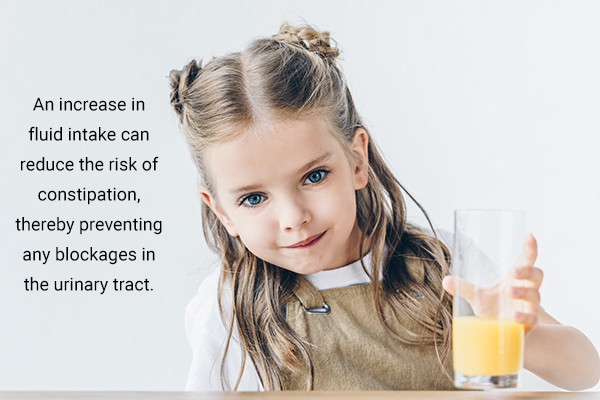
It is important to ensure that your child drinks plenty of fluids when dealing with a UTI. Drinking more liquids helps dilute the bacteria concentration and allows more effective “flushing out” of the harmful microbes. (2) The increased fluid can also reduce the risk of constipation, thereby preventing any blockages in the urinary tract.
- Give your child water to drink at regular intervals. Do not give water to children less than a year old without consulting your doctor.
- In addition, you can give your child milk, freshly extracted fruit or vegetable juice, and homemade soup.
- Do not give your child caffeinated or carbonated beverages, which can irritate the bladder.
2. Encourage your child to go when needed
Keeping a full bladder for a long time or resisting the urge to urinate can contribute to a UTI. It increases the risk of bacterial growth. It also increases pressure on the kidneys, which again is not good for your child’s health.
Encourage your child to urinate often and empty his or her bladder each time. This helps flush bacteria out of the urinary tract.
If needed, set a reminder and tell your child to use the bathroom more often. Inculcate the habit of using the bathroom before going to bed, in particular, so that the child can relieve himself/herself and not wet the bed while sleeping.
3. Change the diapers frequently
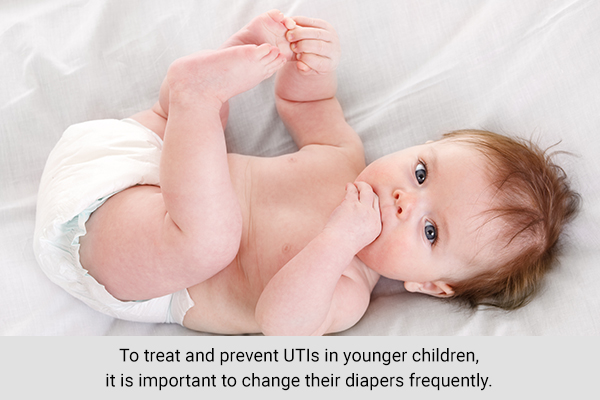
To treat and prevent UTIs in younger children, it is important to change their diapers frequently. This averts the spread of bacteria from soiled diapers to the urethra, which can subsequently give rise to UTIs.
Along with changing the diapers, it is important to properly clean your child’s genital area. Use gentle cleansers that do not irritate the skin.
A 2013 study published in the Indonesian Journal of Pediatrics and Perinatal Medicine found that a lower frequency of changing disposable diapers daily is associated with a significantly higher UTI incidence in children. (3)
Also, the type of diaper you are using for your child can increase the risk of a UTI. A 2010 study published in the Iranian Journal of Pediatrics found that the use of superabsorbent diapers could be a risk factor for UTIs in infant girls. (4)
Ask your doctor about the type of diaper that you can safely use for your child to reduce the risk of UTIs.
4. Provide proper toilet training
Both the American Academy of Pediatrics and the Canadian Pediatric Society advise starting the toilet training process as soon as the child shows any inclination towards learning it and no later than when he/she is 18 months of age. (5)
Furthermore, potty training must also include lessons about the importance of good hygiene. You must start out early when it comes to nurturing appropriate sanitary habits in children, especially because they are most impressionable at this tender age.
Teach your child to wipe from front to rear, not from rear to front. This will help prevent germs from spreading from the rectum to the urethra.
Also, teach your child to continue wiping with fresh toilet paper until it comes out clean. They should also be taught how to flush the toilet and use the bidet if you have one.
5. Give probiotic yogurt
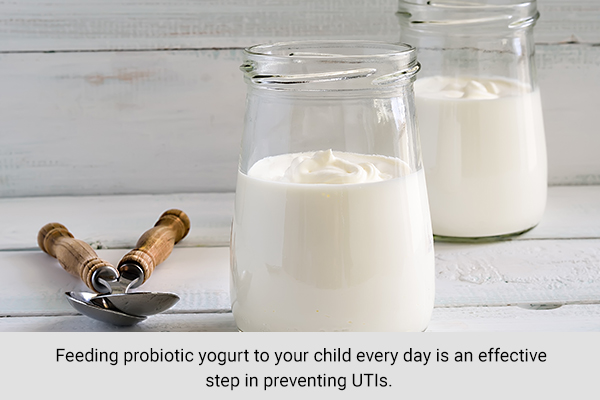
Feeding your child probiotic yogurt every day is another effective step in preventing UTIs. Probiotic yogurt contains billions of friendly bacteria that help fight off infection-causing bacteria.
Regular intake of benign bacterial flora also helps maintain a healthy pH level and strengthens the immune system.
A 2013 study published in the Iranian Journal of Pediatrics found that the consumption of probiotics and antibiotics in children with recurrent UTIs is safe and more effective in reducing the incidence of febrile UTIs in comparison with prophylactic antibiotics alone. (6)
- You can feed 1 cup of probiotic yogurt with live cultures to your child daily. You can also try a smoothie made with probiotic yogurt.
- Along with yogurt, you can give your child other fermented foods, such as kimchi, sauerkraut, and sour pickles.
6. Avoid bubble baths
To reduce the risk of UTIs, particularly in girls, avoid giving them bubble baths. Bubble baths can allow bacteria and soap to enter the urethra and may also cause irritation.
A 2006 study published in the Archives of Disease in Childhood reports that while there is little evidence to support the avoidance of bubble baths as a step to prevent UTIs, bubble baths are nonetheless an irritant to a child’s urinary tract. (7)
For younger children, showers are always more preferable than baths. However, it’s important not to leave them unsupervised when they take a shower.
7. Give cranberry juice
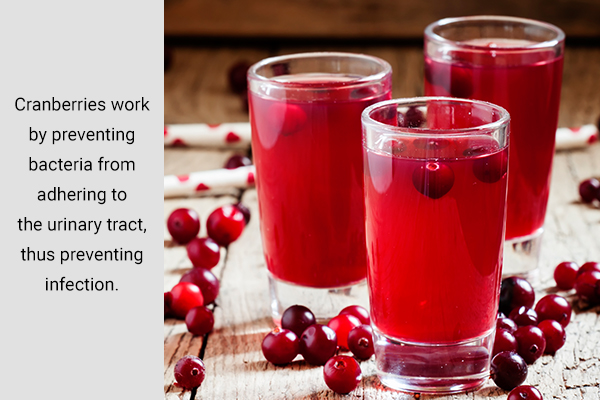
Unsweetened cranberry juice is another very good natural remedy for UTIs in children. Cranberries work by preventing bacteria from adhering to the urinary tract, thus preventing infection.
A 2012 study by the Canadian Family Physician reports that while cranberry juice is very safe for most children, its acidity makes the juice rather unpalatable for many children. The proper dose of cranberry juice to prevent UTIs in children, however, has yet to be determined. (8)
A 2011 Brazilian study found that cranberry may possibly be a valid alternative to traditional antibiotic prophylaxis. (9)
- Give your child 8 ounces of unsweetened cranberry juice a day.
- If your child doesn’t like cranberry juice, you can try cranberry juice concentrate in tablet form.
8. Increase your child’s vitamin C intake
Increasing your child’s intake of vitamin C could protect against UTIs.
Vitamin C is effective, as it increases the acidity of the urine, thereby killing the bacteria that cause the infection. Moreover, vitamin C is good for your child’s immunity. (10)
- Including more fruits and vegetables that are especially high in vitamin C in your child’s diet is a good way to increase intake. Some good choices include red peppers, oranges, grapefruit, and kiwis.
- You can also consult your doctor about giving your child a vitamin C supplement.
9. Avoid constipation
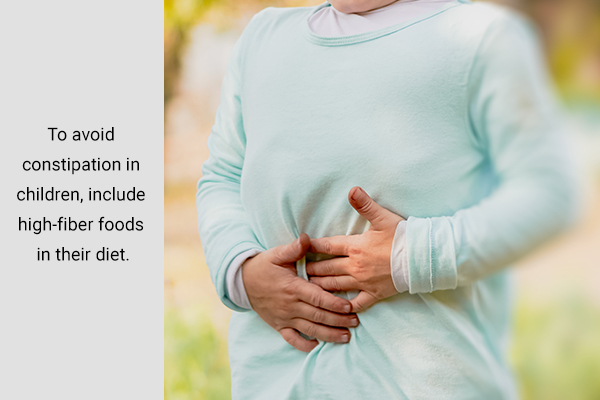
Hard stools can press against the urinary tract and block the flow of urine, allowing bacteria to grow. Hence, it is important to help your child have regular bowel movements and prevent constipation. (11)
To avoid constipation in children, include high-fiber foods in their diet. Fiber helps soften the stools by drawing water into them, making them bulkier and easier to pass.
- Give your child high-fiber foods, such as broccoli, pears, peaches, peas, and skinless apples. You can feed these pureed or boiled.
- You can also give children cooked grains, such as barley, oats, and quinoa.
10. Choose the right clothes
The clothes you choose for your child also play a key role in reducing the risk of UTIs. It is important to choose cotton underwear and loose-fitting clothes so that air can circulate and keep the area around the urethra dry.
Avoid dressing your child in tight jeans and other tight-fitting pants that trap heat and moisture. Dress them in loose pants or skirts instead to promote air circulation and reduce the chances of bacterial growth.
Make sure to change your child’s underwear daily. Wash their underwear in hot water using a mild detergent. Also, do not leave your child in a wet swimsuit for an extended period of time.
Causes of UTI in Children
- The most common pathogen responsible for UTIs in children is Escherichia coli (coli), accounting for approximately 85% of the cases. (12)
- UTIs occur more often in girls, particularly when toilet training begins. This is because girls have a shorter urethra, which makes it convenient for the infection-causing pathogens to travel up in the urinary tract.
- UTIs are quite rare in boys under 1, and when they do occur, the condition is usually stemming from an anatomical abnormality and is more prevalent in uncircumcised males because the accumulation of bacteria under the foreskin paves the way for infection.
- Vesicoureteral reflux: Due to faulty valves in the ureters, urine tends to spill back up into the ureters and kidneys from the bladder. This is a rare kind of birth defect.
- Babies with soiled nappies who tend to fidget a lot during a diaper change, tend to get their urethras contaminated by poo particles.
- A constipated child may have a hard time peeing normally because the inflamed large intestine creates blockages in the urinary tract, disrupting normal urination.
- Wiping from near the anus towards the urethra after a bowel release can increase the chances of the disease-causing bacteria gaining access into the urethra, especially among girls.
Other factors that can increase a child’s risk for a UTI include:
- A structural deformity or blockage in one of the organs of the urinary tract
- Dysfunctional urinary tract
- Bubble baths
- Tight-fitting clothes
- Inadequate toilet hygiene or unsanitary bathroom habits
- Infrequent urination
- Holding on to your pee for long periods of time
- Cleaning the anal and urethral areas the wrong way
Symptoms of UTI in Children

Infants and very young children may not show any symptoms when suffering from a UTI. However, in slightly older children, symptoms may include:
- Fever
- Poor appetite
- Vomiting
- Diarrhea
- Irritability
- A general feeling of illness and lethargy
- Burning sensation while peeing
- Pee that reeks of a foul odor
- Cloudy pee
- An urgent need to pee and then relieving only a few drops of urine
- Uncharacteristic toilet habits including bed wetting
- Abdominal cramps
When to See a Doctor
Consult your doctor if you notice any of the following symptoms that may indicate a possible kidney involvement:
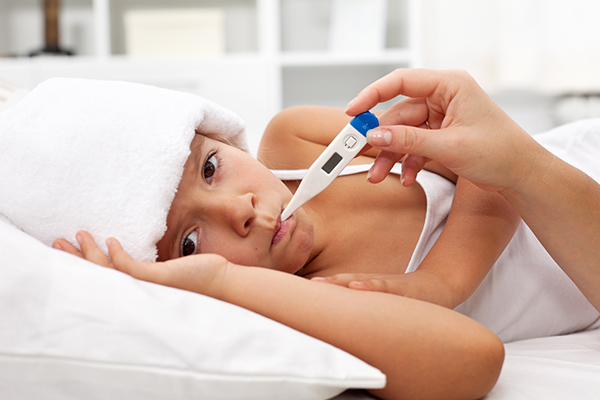
- Soaring fever
- Shaking with chills
- Skin appears washed out and is warm to touch
- Severe pain in the abdomen, back, or the sides where the kidneys are located
- Extreme and constant tiredness
Younger children require extra precaution because they don’t exhibit the typical symptoms of UTI, making it harder to diagnose the problem.
If your child continuously runs a high fever without displaying any other obvious symptom of an illness such as runny nose or an earache, consult your pediatrician at once to rule out a probable UTI.
Particularly for children below age 1, it is advisable to follow the advice of your doctor.
Final Word
Catching an infection in its early stages makes it easier to treat. This applies to UTIs as well which, if left untreated for a long time, can end up causing irreversible renal damage and even sepsis (infection of the bloodstream) that can prove fatal.
It is, therefore, imperative to address any sign of UTI in children with utmost urgency to avoid such life-threatening complications later.
- Was this article helpful?
- YES, THANKS!NOT REALLY



